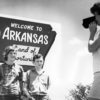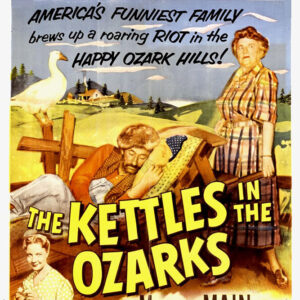calsfoundation@cals.org
The Kettles in the Ozarks
The Kettles in the Ozarks (1956), directed by Charles Lamont, was the ninth in a series of ten comedies made by Universal International Pictures. The characters of Ma and Pa Kettle were introduced in supporting roles in The Egg and I (1947), starring Claudette Colbert and Fred MacMurray. Marjorie Main, as Ma Kettle, was nominated for an Oscar for Best Supporting Actress for The Egg and I, and the first feature starring the Kettles, Ma and Pa Kettle, followed in 1949.
The Kettle series began after the years 1937–1945, which Anthony Harkins in his book Hillbilly identifies as the period of “the hillbilly stereotype at high tide.” During that time, Judy Canova and the Weaver Brothers and Elviry made films for Republic—including Down in “Arkansaw” (1938) and Arkansas Judge (1941)—while Arkansan Bob Burns worked at Paramount (including appearing in The Arkansas Traveler, 1938), and the Lum & Abner show was on the radio (1931–1955) followed by six Lum & Abner films (1940–1946).
The Ma and Pa Kettle movies were set apart from most hillbilly films not only chronologically but also by their settings. Most rustic films were set in the Appalachians or the Ozarks, but Betty MacDonald set her autobiographical novel The Egg and I in the backwoods of the state of Washington, and the Colbert/MacMurray film was set there. Many of the Ma and Pa Kettle films were also set in Washington, but other films in the series cast the Kettles as fish out of water in New York City (Ma and Pa Kettle Go to Town, 1950), Paris (Ma and Pa Kettle on Vacation, 1953), and Hawaii (Ma and Pa Kettle in Waikiki, 1955).
The Kettles in the Ozarks was the only film in the series placed in a setting that audiences actually associated with hillbillies. It was also the first film in the series without Percy Kilbride (Pa Kettle). The actor had tired of playing slow-talking, work-averse Pa, in contrast to Main’s robust, loud-mouthed Ma. Kilbride had less success than Main finding work outside the Kettle franchise. He retired in 1953. The Kettles were so profitable for Universal that the studio carried on without Kilbride.
The first ten minutes of The Kettles in the Ozarks has Ma trying to control her unruly gang of children in a railroad station and on a train. They arrive at the fictional town of Mournful Hollow, Arkansas, where Uncle Sedge Kettle (Arkansas-born Arthur Hunnicutt) is at least as lazy and muddled as his brother Pa. He has a thick country accent and is usually seen lying on a sofa or a well-cushioned wheelbarrow, directing people who are actually doing work. The film has many of the worst Hollywood stereotypes about hillbillies, including the dilapidated farm, clothes a few decades out of style, a neighboring farmer who makes a woman do the plowing, and Sedge muttering “I’ll get around to fixin’ that someday” whenever some piece of equipment fails.
The movie is propelled by the pratfalls and jokes typical of the series. Ma solves several problems. She saves the farm, which Sedge had almost lost to the bank. She and the children drive away a band of city gangsters who have taken over the barn and set up as bootleggers. She gets Sedge, who is as averse to marriage as he is to work, to marry Bedelia (Una Merkel), who has been waiting for twenty years.
Variety (March 7, 1956) considered The Kettles in the Ozarks “very so-so” and “pretty thin fun after eight times at bat” with “comedy antics dating back to the silents.” They felt that Percy Kilbride’s presence was “sorely missed” while Hunnicutt “[did] Uncle Sedge to the point of ennui.” In her biography of Marjorie Main, Michelle Vogel considers the movie “a poor entry in the Kettle series” with a “weak story line.” Coupled with bad reviews, The Kettles in the Ozarks had disappointing box office returns.
Universal made just one more movie in the series, The Kettles on Old MacDonald’s Farm (1957), which returned the family to the Pacific Northwest and brought back Pa, played by Parker Fennelly. The quality of this last Kettle film and the box office receipts were about the same as for the Ozarks entry, and the Kettles were finished in Hollywood.
After the Kettle movies, hillbillies fled the big screen for television and appeared in The Real McCoys (1957–1963), The Beverly Hillbillies (1962–1971), Petticoat Junction (1963–1970), Green Acres (1965–1971) and Gomer Pyle: USMC (1964–1969).
For additional information:
Harkins, Anthony. Hillbilly: A Cultural History of an American Icon. New York: Oxford University Press, 2004.
“The Kettles in the Ozarks.” Internet Movie Database. https://www.imdb.com/title/tt0049404/?ref_=nm_flmg_act_4 (accessed December 31, 2018).
Vogel, Michelle. Marjorie Main: The Life and Films of Hollywood’s “Ma Kettle.” Jefferson, NC: McFarland, 2006.
Williamson, Jerry W. Hillbillyland: What the Movies Did to the Mountains and What the Mountains Did to the Movies. Chapel Hill: University of North Carolina Press, 1995.
Michael Klossner
Little Rock, Arkansas
 Arkansas's Image
Arkansas's Image Arts, Culture, and Entertainment
Arts, Culture, and Entertainment World War II through the Faubus Era, 1941 through 1967
World War II through the Faubus Era, 1941 through 1967 The Kettles In The Ozarks Poster
The Kettles In The Ozarks Poster 




Comments
No comments on this entry yet.